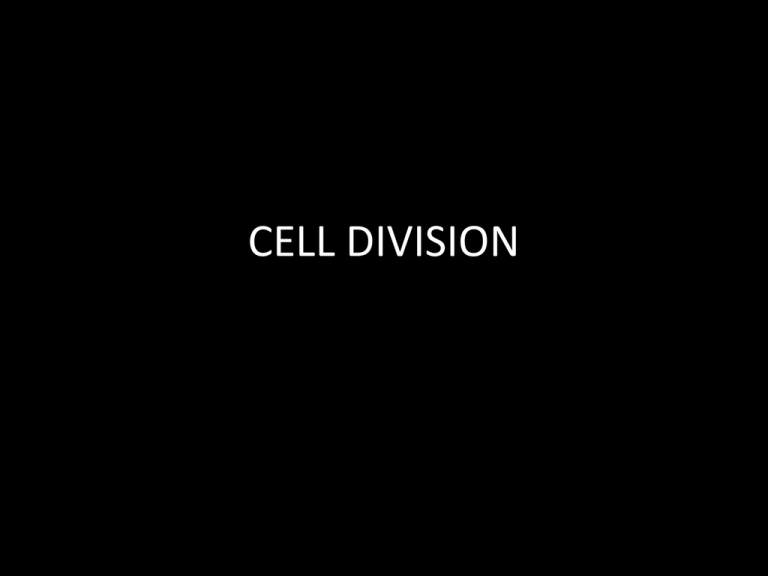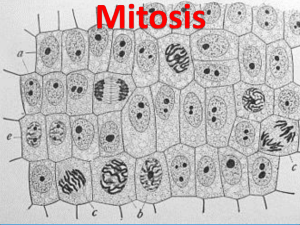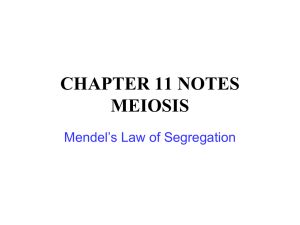
CELL DIVISION
Think about it…
How many different cells make up our body?
CELL DIVISION
Some cells divide frequently
(some human skin cells divide once/hour)
Some cells divide occasionally
(liver cells divide about once/year)
Some cells don’t divide once they form
(nerve cells)
Asexual Reproduction
• Production of genetically identical offspring
from a single parent cell (CLONES)
• Bacteria (binary fission), some multicellular
organisms (budding)
• We do it too! (mitosis)
PRO: Fast, simple
CON: Same DNA, no diversity
Sexual Reproduction
• Fusion of two gametes genetic info
PRO: Diverse DNA
CON: Takes longer, 2 gametes needed
95% of the time DNA is loosely
coiled in nucleus(CHROMATIN)
Chromatin condenses into
tight complex of visible
chromosomes during cell
division (5% of time)
Duplicated Chromosome:
A closer look…
Chromatid
Protein DNA is coiled
around
Cell Division
• Process in which a parent cell divides to
produce daughter cells
• It is estimated that more than 25 million cells
undergo division each second in an adult
human
Eukaryotic Cell Cycle
CELL CYCLE
INTERPHASE
• Phase in preparation for cell division
• Cell spends about 90% of its life in interphase
• Divided into 3 phases:
G1 – gap phase 1
- Cell growth, performs cell duties, DNA in form of
chromatin
S – synthesis
- DNA synthesis (replication)
G2 – gap phase 2
-Prepares to undergo mitosis
Cell Cycle checkpoints
Checkpoints in G1 and G2 ensure the cell is prepared to
enter into the next phase of the cell cycle
(adequate nutrition, size, not damaged…)
CELL CYCLE
M phase = Mitosis and Cytokinesis
Mitosis
• Parent cell nucleus
undergoes cell
division
• 4 Phases
– Prophase
– Metaphase
– Anaphase
– Telophase
Cytokinesis
• Process in which the
cell finally splits into
two daughter cells
Mitotic spindle
• Cells contain centrioles
made of microtubules
and produce long fibers
called spindle fibers
MITOSIS
Mitosis: PROPHASE
• Chromatin fibers condense into
visible chromosomes
• Nuclear envelope breaks down
• Mitotic Spindles form; microtubules
attach to chromosomes @
centromere to direct their
movement (like puppet strings)
microtubules
Mitosis: Metaphase
• Chromosomes gather in middle
of cell between the two ends of
spindles
• Form a line at “equator” of cell
Mitosis: Anaphase
• Sister chromatids separate from
“partner”
• Spindle microtubules shorten,
bringing chromosomes closer to
opposite poles (reeling them in)
Sister
Chromatids
Mitosis: Telophase (and cytokinesis)
• Chromosomes reach opposite poles of
spindle
• 2 new nuclear envelopes reform around
each new set of daughter chromosomes
• Chromosomes uncoil (prophase….in
reverse)
• Cytokinesis completes cell division by
dividing cytoplasm in 2, each with a
nucleus
Mitosis in action!
Cancer
• A disorder where body cells lose the ability to
control cell growth (defective gene)
• Don’t respond to regulatory signals
• Tumor- a mass of cells
• benign (not cancer, doesn’t spread)
• Malignant (invade and destroy surrounding
tissue metastasis)
Cancer
• Smoking, chewing tobacco, radiation, genes
• Treatments
– Remove tumor
– Radiation
– Chemotherapy uses chemicals that target rapidly
dividing cells (downside, affects normal cells also
undergoing cell division)
Embryonic Stem Cells
• Have the ability to differentiate into almost
any cell in body
• Possibly treat damaged tissue
(heart attacks, stroke brain tissue, spinal cord)
• Apoptosis- Cells die or it is “programmed” to
die.
• Important in development
• Eukaryotes have two different types of cells
– Somatic - include skin, internal organs, bones, blood,
etc. (cells produced thru MITOSIS)
– Gametes - egg or sperm (cells produced thru MEIOSIS)
–Somatic cells have 46 chromosomes or 23 pairs of
chromosomes, 1 set of 23 from Mom and 1 set of 23 from
Dad = DIPLOID cell (2N)
–Gametes have 23 chromosomes; HAPLOID (1N) when
gametes meet during conception they “fuse” together
• HOMOLOGOUS pairs of chromosomesPair of corresponding chromosomes (1 from
mom, 1 from dad)
• Pairs 1-22 are autosomal
• 23rd pair of chromosomes are sex
chromosomes (XX or XY)
A Karyotype is an Arranged Picture of Chromosomes At Their Most Condensed State
Note that almost all chromosomes come in homologous pairs.
Boy or
girl?
A normal
human
karyotye
Mitosis – process in which a eukaryotic
somatic cell divides into 2 identical daughter
cells
Diploid cells Diploid cells
Meiosis – process in which the number of
chromosomes is halved to produce gametes
(ie eggs and sperm)
Diploid cells haploid cells
Meiosis-Prophase 1
•Homologous chromosomes pair up (TETRAD)
•Chromosomes swap genetic information called
Crossing over
Tetrad
MEIOSIS- METAPHASE I
Tetrads line up in center of cell
MEIOSIS- ANAPHASE I
Homologous chromosomes separate and move to
the opposite poles
IMPORTANT: CHROMATIDS DO NOT SEPERATE
MEIOSIS- TELOPHASE I
Nuclear membrane reforms around each cluster
of chromosomes
Cytokinesis follows, forming two new cells
MEIOSIS- PROPHASE II
New spindle forms around the chromosomes
MEIOSIS- METAPHASE II
Chromosomes line up at the equator
MEIOSIS- ANAPHASE II
Chromatids move to the opposite poles
MEIOSIS- TELOPHASE II
Nuclear envelope forms around each new set of
chromosomes, cytokinesis. 4 haploid sex cells
Haploid cells to Sperm and Eggs
Spermatogenesis – Each of the 4 haploid cells
become spermatozoa
Oogenesis – Only 1 of the 4 haploid cells become an
ovum (egg cell)
But its just a little more
complicated than that…
What happens next?!
Spermatogenesis
Oogenesis
Meiosis I begins
before birth
Puberty elicits
continuation of
Meiosis
Hormones play major
role
Get Excited....Meiosis
Animation!!
Meiosis Contributes to Genetic Variation
• 3 Main Ways lead to genetic variation
– 1. Independent Assortment
– 2. Crossing Over
– 3. Random Fertilization










